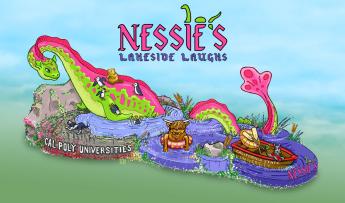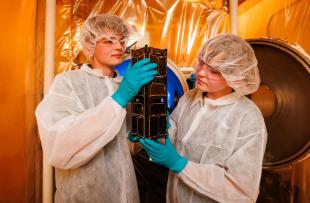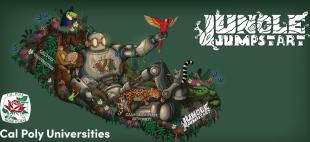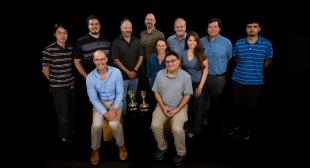California Impact
Pack Your Bagpipes: Design for Rose Float's 76th Entry Features Loch Ness Monster

Cal Poly students will bring the mythic Loch Ness monster out of the depths to join some land-dwelling friends in “Nessie’s Lakeside Laughs,” the Cal Poly universities Rose Float team’s 2025 entry for the 136th Pasadena Tournament of Roses Parade on Jan. 1.
Measuring 55 by 17 feet, and rising 21 feet, the schools’ 76th Rose Parade entry will depict an animated lakeside party featuring puffins sliding down Nessie’s fin, beavers crafting with found driftwood, a Scottish terrier riding a paddleboat on the loch (lake or sea inlet in Scottish and Irish Gaelic), and a smiling Highland cow spinning in an innertube.
The happy payoff for Nessie’s bravery honors the 2025 Rose Float theme “Best Day Ever!” — which celebrates life’s best moments — those unexpected times that bring a smile, warm the hearts and fill people with joy.
“The inspiration for this float comes from that place of terrifying wonder, when you discover something new and end up enjoying it to the fullest,” said Pomona team president Brooke Handschin, a mechanical engineering senior, and San Luis Obispo team president Collin Marfia in a joint statement.
The Cal Poly universities Rose Float is the only student-designed and constructed entry in the Rose Parade. A joint effort of student teams from Cal Poly and California State Polytechnic University in Pomona, the team has earned 62 awards since their parade debut in 1949. The team’s 2024 entry “Shock n’ Roll: Powering the Musical Current” received the Crown City Innovator Award, which recognizes innovations in technology and imagination.
The 2025 concept featuring Nessie was suggested by Cal Poly alumna Holly Dufek (Architecture, ’24), a member of the Cal Poly leadership team for the 2022 float, “Stargrazers,” varies from past entries.
“One of the desires the team had this year was to build a main, large, striking element,” said Marfia, who is seeking a master’s degree in higher education, counseling and student affairs. “The past few years we have spent time crafting multiple characters and creations on the float that equally draw focus, but we really wanted to create one large character who would steal the show.
“We reflected on past floats, like ‘Happiness is Finding a Friend’ (1974), ‘Guardians of Harmony’ (2008), and ‘A New Leaf’ (2017). Once we saw Nessie and talked about what we could do with her, we were hooked.”
The float’s movements will be controlled by the team’s newly designed and built animation system. Most mechanisms will be powered hydraulically, with smaller elements controlled electronically. Audiences can expect Nessie, towering at two stories tall, to move her neck and head to survey her friends sliding, paddling and playing in the water.
“We will also be continuing our innovations with neoprene concealment and ‘floating rings’ mechanisms to give Nessie much more natural movement in her head, neck, and tail,” Marfia said.
In addition, the student team will ramp up the decor on the float’s centerpiece.
“This year, Nessie will be shaped with in-sets in her main structure that will allow us to place fresh, vialed flowers in large portions of her body,” he said. “We have done this before on a much smaller scale with ‘Road to Reclamation’ (2023) in the shell of the snail on the front of the float. It is the same technique from a past year but done on a much grander scale than we have ever done before.”
Bringing the scene to colorful life are florals that “take advantage of the vibrant colors and unique textures of a lake and the animals who inherit it,” the two team presidents said. The lake will be mostly blooms including irises, roses and baby’s breath. Dry materials, such as black moss, cotton and coconut husks, will cover and color the land animals.
Designing and building the float is nearly a yearlong process for the team, which includes a core leadership of 60 students across the two campuses. The process involves: building, adjusting and fine-tuning the mechanical, drive and animation systems; welding the structural supports and shaping the design elements; testing decorative material; and sheeting and foaming before the students can begin adding final design elements.
Cal Poly Pomona traditionally builds the front half of the float base (known as the pod), while students in San Luis Obispo build the back. Design elements are shaped by both teams.
Cal Poly will wrap up its on-campus portion of construction in mid-October, when the elements and the motorized chassis will be trucked south to the Pomona campus where the halves will be united in an annual ceremony marking the countdown to the Pasadena classic on Jan. 1.
Members from the Cal Poly campus will travel to Pomona each weekend to join their counterparts in installing and testing the elements. Students will continue to build the float through the fall while balancing studies and completing final exams until it is ready to join other float entries to be evaluated by Rose Float judges the day before the parade.
“We are both most excited to see all our team’s hard work come to fruition on New Year’s Day,” said Handschin and Marfia. “When people see the float come down Colorado Boulevard, they’ll see a beautiful float with Nessie and her friends. We’ll see that too — but we’ll also see every step that our team went through to get there.”
Want more Learn by Doing stories in your life? Sign up for our monthly newsletter, the Cal Poly News Recap!




